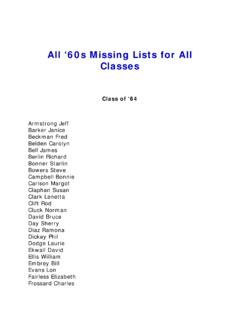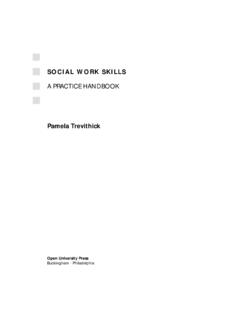Transcription of INTRODUCTION T O CROSS-COUNTRY SOARING - Harris Hill
1 INTRODUCTION TO CROSS-COUNTRY SOARING This publication does not offer any new, brilliant strategies, nor does it reveal any deep guarded secrets. Most of the material presented here can be found in other publications, and have been used by glider pilots for many years. In fact, some of the techniques presented herein were used by pilots as far back as in the 1930s. This is merely an effort to compile most of the practical aspects of CROSS-COUNTRY SOARING in one handy booklet for the aspiring CROSS-COUNTRY pilot. As the same techniques apply to contest flying, this material is also helpful for those intending to join the world of competitive SOARING . Kai Gertsen April 1999 Revised 2006 CONTENTS TYPE OF MAP 5 HOW TO FIND 11 WHERE TO 16 HOW 22 WHEN TO 25 FINAL 29 LOW 30 EFFECTS OF 31 HOW TO GET 32 LEAD AND 33 PRACTICE X-C WHILE FLYING 34 FIRST 37 INTRODUCTION TO CROSS-COUNTRY As you read through this booklet you may get the impression that it applies to racing, and it does.
2 However, though you may only be interested in recreational flying, you need to apply most of these techniques to some degree if you want to go somewhere. In bygone days when most of our flights were downwind dashes we didn t need to worry too much about efficient flying in order to get some sense of accomplishment. On most reasonable SOARING days the wind usually blows at 15 mph, so if we managed to add a mere 25 mph we would cover a respectable 160 miles on a four hour flight, at 40 mph. Times have changed, Out and Returns have now become fashionable. With that same performance, in similar conditions, it would take the same amount of time to complete an Out and Return flight to a turn point 32 miles upwind.
3 In contest flying were every minute counts, you need to know and apply all of this material to the fullest extent. TYPE OF GLIDER While the latest ultra-performance glider with an L/D approaching infinity would be nice, an intermediate type with a glide angle of 30:1 will do well enough. On the other hand, on the average eastern day, it is simply not possible to successfully practice many of the following CROSS-COUNTRY techniques in anything with much less performance. However, making your very first CROSS-COUNTRY flights in a glider with a low wing-loading, such as a Schweizer 1-26 or K-8 is not such a bad idea as the low stalling speed and short landing characteristics will make those first off-airport landings considerably less stressful.
4 When flying a glider with this level of performance the best policy is to stay as high as possible and don t pass up too many thermals. Also, chances are you will have more fun and less aggravation going straight downwind. MAP PREPARATION While navigation is done almost exclusively by GPS these days, it is a good idea to have a map available in case the GPS decides to close up shop. But to be useful, the map needs to be prepared for the occasion. Here is some helpful advice. In a sailplane, we do not have the time or space to unfold and fold sectional charts. We need a single, one-sided map which covers the area we intend to operate within. Unfortunately, the sectional charts have been carefully arranged such that most glider ports are located near the border of charts, so that typically two or more sectionals need to be joined together to create a one piece, single sided map.
5 This can be done by using clear tape. The next step is to draw five or six concentric circles centered around home base. The purpose of these circles is to enable you to readily estimate your distance from home when you are in the vicinity, and the altitude required to get there, basically turning the map into an oversimplified glide calculator. Space the circles at five miles increments. When working out the altitude required to get home, figure on losing 200 ft per mile or 1,000 ft per circle. These are nice handy, round numbers to work with and this gives you plenty of margin as it works out to an L/D of :1. Some allowance of course, has to be made for the effect of wind, which on most SOARING days in the eastern part of the country amounts to about 15 mph.
6 A good rule of thumb is to anticipate covering approximately 3 miles per thousand feet, or losing 1,400ft. in 5 miles if going in to the wind. Downwind should get you about 6 miles for every 1,000 ft. loss of altitude. In addition to the circles, mark all the turn points you intend to use in the future. If you operate within a contest area, mark your map with all the official turn points. When all done, it s a good idea to cover your map with clear vinyl to protect it from sweat and tears. The type made for covering kitchen cabinet shelves works well. NAVIGATING BY MAP Navigating by map need not be all that complicated; here is a simplified version. Before starting with reference to the map and a prominent terrain feature such as a lake or town, point the glider on the heading you need on the first leg.
7 Don t forget to make some allowance for crosswind. Note the compass reading, and now you know the compass heading for the first leg. Repeat this process after rounding each turn point. If you are low and momentarily confused with respect to your position (in other words, lost), concentrate on getting as high as you can before trying to sort out your navigational problems. GPS USAGE If you will be using a GPS on your first CROSS-COUNTRY , be sure you are well versed in its operation beforehand. By all means, do not try to figure out how to use a GPS during you first flight away from home, you will be busy enough as it is. When navigating by GPS it is extremely useful to have an 8 " x 11 map with all the turn points, for quick reference.
8 OFF-AIRPORT LANDINGS At some sites it may be possible to lay out a route which will permit airport hopping. Based on conditions in the eastern part of the country , the airport spacing should not be greater than 20 miles. The idea is that you don t go beyond reach of one airport until you are within reach of the next so as to avoid having to make an off-airport landing. This is an excellent way to get initiated and, if possible, the first few cross -countries should be done this way. However, serious CROSS-COUNTRY SOARING cannot be done without an occasional visit with a farmer. Off-airport landings is a subject in itself and is covered in a separate publication. Field landings are not to be taken lightly, there is more to this subject than might be expected.
9 On the other hand, don t let your apprehension of a potential field landing prevent you from pursuing the thrill and excitement of CROSS-COUNTRY SOARING . There is no question that off-airport landings entail a greater risk than landing at an airport, but if you are fully prepared, the risk can be contained to an acceptable level. Just be sure you are ready to cope with this challenge before setting off. Successful off-airport landings are 99% skill and 1% luck. Good judgment comes from experience, which comes from bad judgment. THERMALLING Efficient thermalling is a prerequisite for successful CROSS-COUNTRY flying. In contest flying, it is absolutely imperative. On an average day, a couple of minutes more in each thermal can add 15 or 20 minutes to a 150 mile flight.
10 That much time can be lost in the initial centering process alone if your performance is not up to par. Also, when thermals are feeble the right thermalling technique can make the difference between going up or going down. Prior to solo flight, most training is concentrated on take-offs, patterns and airmanship, as it should be. Occasionally, when a thermal is encountered the student is instructed to circle, then to straighten out here and there. This is done mostly for the purpose of prolonging the flight. Some will receive some limited instruction in the basic principles of thermalling, but learning to center quickly and maximize the rate of climb needs special attention, and cannot be mastered before airmanship is fully developed.





